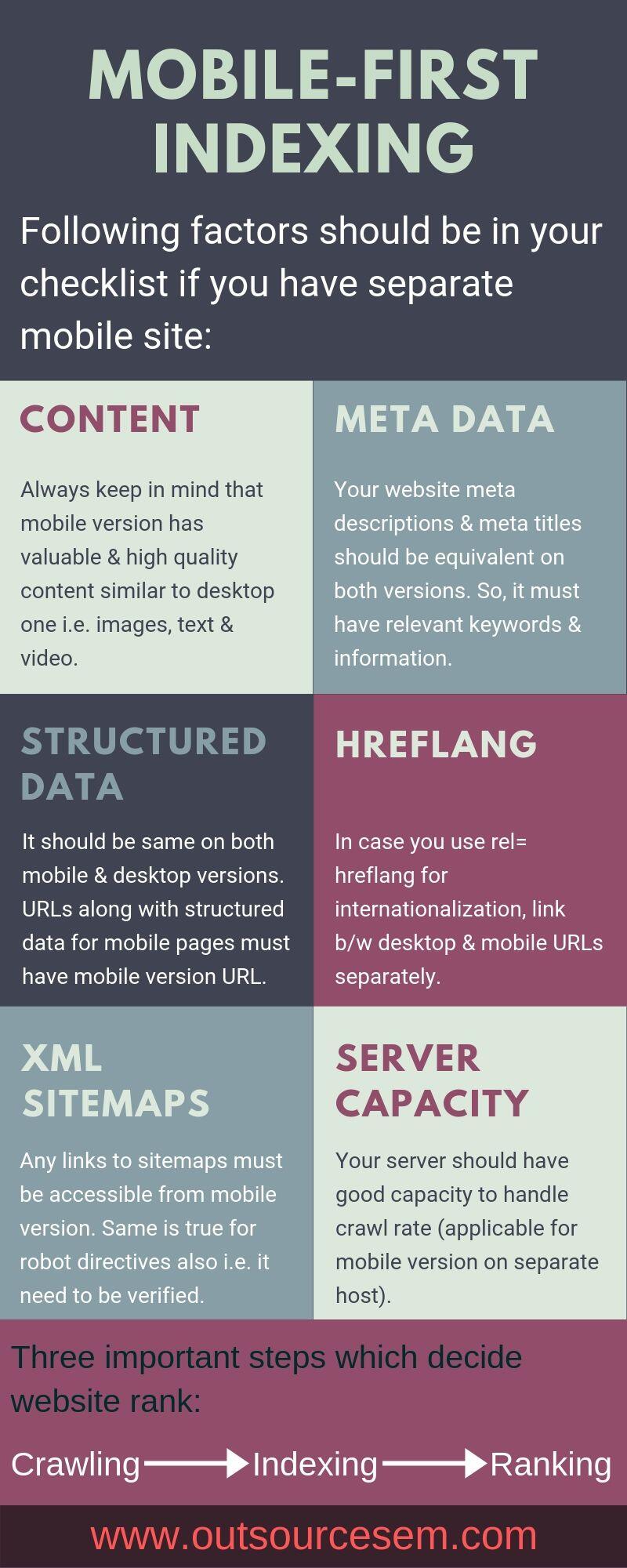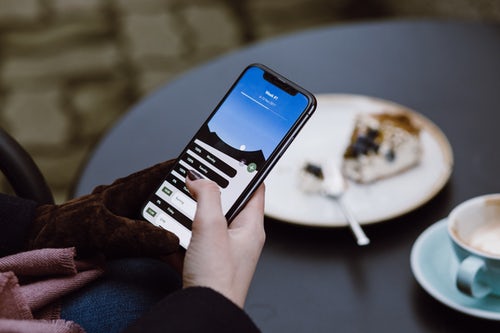Getting better rank is a desire of every website owner. No one wants to get lower rank & poor website SEO. Now-a-days, mobile-first indexing has become quite useful in improving website SEO & taking your website to higher position. So, how it will help your website to get better position. Do you need to have separate mobile friendly website? Or, it can work with your desktop version website? Or, having a mobile friendly website is enough for this? To get all the doubt cleared, we will discuss each & every aspects of mobile-first indexing in this post.
Mobile-first Indexing:
From the word itself, you can easily predict that Google typically uses mobile version of a web content for ranking & indexing. Earlier, indexing was done for desktop version of a web content when analysing & evaluating the relevancy of that content to any visitor’s query. Since, today majority of users do Google search from their mobile devices, hence, Googlebot crawls & index web pages with smartphone agent.
What it means for different type of sites
• Desktop only: If your website is desktop based & lacks mobile friendly version, then no change is required. Because, desktop version & mobile versions are same in nature.
• Canonical AMP: If all your webpages are created on AMP HTML platform. Then, no change is required. Mobile version is similar to desktop one.
• Responsive web design: If your site adjusts for screen size, then you don’t need to make any changes. Here, mobile version is similar to desktop version.
• Dynamic Serving: It means your site serves different content based on device type. Here, users see only one URL. In this case, Google consider mobile optimized content over desktop one for indexing. To prepare for mobile-first indexing, you can visit here!
• AMP & non- AMP: If your website has both AMP & non-AMP page version. Then, users will see two different URLs. Here, Google considers non-AMP URLs of mobile version for indexing.
• Separate URLs: Each web content URL for desktop also has an equivalent URL that serves content for mobile-optimized one. This type of site is known as m-dot site. Here also, mobile optimized content is being preferred for indexing.
Now, we have gone through different types of website & how mobile first indexing matters for those website? But, what are the important task you need to look upon for mobile indexing. Let’s discuss it.
What to do for mobile-first Indexing?
First-of-all, you do not need to worry about it. As per Google, if your website is identical on both mobile & desktop and it’s responsive then you do not need to do much. We have also discussed it above. Having a responsive website is good but you have to look on other corners also i.e. make sure that load time & mobile page speed should be given priority. Other than that, optimize images & other important website elements carefully for the better mobile experience. One thing which is not ignored in mobile first indexing is that content which is hidden or collapsed etc. due to some space issues will be treated similar to visible content, it won’t be ignored like previously.
Following terms should be in your checklist if you have separate mobile site:

• Content: Always keep in mind that mobile version has valuable & high quality content similar to desktop one i.e. images, text & video. Also, the format used on mobile version should be index-able & crawl-able.
• Meta data: Your website meta descriptions & meta titles should be equivalent on both versions. We talked here about equivalent rather than identical because for short character counts, you might make it precise for mobile version. So, it must have relevant keywords & should have same information.
• Structured data: It should be same on both mobile & desktop versions. Also, URLs along with structured data for mobile pages must have mobile version URL. Apart from this, you should always avoid adding irrelevant & unnecessary structured data when considering specific content of a certain page.
• Hreflang: In case you use rel=hreflang for internationalization, link b/w desktop & mobile URLs separately. Here, desktop URL hreflang should be pointed towards desktop URLs & similarly URL hreflang for mobile should point towards mobile URL.
• XML sitemaps: Any links to sitemaps must be accessible from mobile version. Same is true for robot directives (robot meta tags & robots.txt) also i.e. it need to be verified. It must work well on both versions. If you do not know about robot.txt file, then you should be aware of it. It helps in identifying which part of website can be crawled or not. And, robot meta tags helps in identifying the website part which can be indexed.
• Server Capacity: Your server should have good capacity to handle crawl rate on mobile version (applicable for mobile version on separate host).
Till now, you have got clear idea about mobile-first indexing. Our post was ‘how to get better rank through it”. To understand its implementation, firstly we will differentiate between ranking & indexing.
Basic difference between ranking & indexing:
In Ranking, search engine analyses the information to be indexed & determine the web pages that fulfil its criteria according to ranking algorithm, search query & device type. If a website is not indexed, then it cannot get ranked.
In Indexing, the process comprises of reading & storing webpages’ information by indexing robot i.e. Googlebot. Whenever, Google visits & reads any webpage then it stores the information from that page in its index.
From the above discussion we can conclude that indexing is a fundamental thing in search engine optimization (SEO) mobile first index. Firstly, page needs to be indexed, so that it can get ranked.
Mobile vs Desktop rankings
You might have heard from many SEO specialist that once mobile indexing comes into role then mobile & desktop ranking will be same. That is totally wrong. We have differentiated above that ranking & indexing are different things, each having separate function & goals. Since, Google has changes the page indexing process, it doesn’t mean that ranking process is changed. Presently, Google organic ranking may differ based on queries is made from different devices i.e. mobile or desktop. This type of result variation is just because of Google ranking factors & penalties that are in existence for mobile results. So, penalties are not going to change with mobile first indexing, as penalties affect ranking instead of indexing.
Also, there is some other factors that affect ranking differently on mobile & desktop that aren’t going to change because of arrival of new indexing model. So, all-in-all, we must keep our concept clear & shouldn’t be confused with mobile indexing & mobile ranking.
Some common myths about mobile-first indexing:
• Mobile-first Indexing & mobile friendliness are same
We have discussed above that these two things are not the same. They are totally independent of each other. Mobile friendliness is still crucial as it is yet considered as important ranking factor, but it is different from mobile-first indexing. Sites which are not mobile friendly have been moved to mobile first indexing.
• Having poor site quality site to avoid transition
In the world of rapid growth & development, it is poor tactics to stop your growth.
• Ranking will be directly impacted by mobile-first indexing
Google is mainly focussed on ensuring seamless transition as much as possible & ranking should not have negative impact anyhow.
Apart from myths, there are common doubts that SEO professionals enquire for, that are:
How would someone know that his/her website is switched to mobile-first indexing?
If your website has been switched to mobile Indexing, then you will receive a Google search console’s notification. As of June 2019, Google search console have added some new features that will indicate about your website status. You may find a pop up which will notify the date & time when your website has been switched to mobile-first indexing together with chart annotation & primary crawler identified. It is recommended to double check your log files to get the exact date.
Do mobile indexing affect the style of content and serve ads being displayed on mobile site?
Assuming that your latest approach to ads are creating bad user experience then you will require to look on that. Also, we have discussed earlier that to manage space, you are hiding some content of your mobile site. Then, this is not an issue as content will be loaded similar to the fully visible content till it is index-able & crawl-able.
Do responsive sites & mobile friendly websites show any kind of differences?
The difference depends upon the required updates for this change. Assuming that you have a responsive site, this means you have everything for your mobile version which is also the part of desktop version. Here, the main problem is that you have to be confirmed that mobile experience is optimized well for better user experience (e.g. load time, page speed, navigation, etc.). Make sure that having a mobile site separately means that your mobile site should contain each and everything that your desktop site contains. If, it’s not having it then you need to work much based on your mobile strategy.
Tips: Given below are some characteristics features which you can follow to get good results.
• Site Speed: It plays a significant role in mobile performance. Make sure you have faster page load speed.
• Ease of use: Design should be such that it becomes easy to use on mobile devices. It is always recommended to make buttons & clickable links.
• Interstitial popups: You should always avoid having interstitial popups as it might affect your website SEO & can cause higher bounce rate. Instead of that use some other alternatives that will not harm your website SEO.
Conclusion:
So far we have discussed about ‘Mobile-first Indexing’ and how important it is for your website. Now, you have understood the way it works & what it can do for your website. You have come across in this that Google uses the mobile version of a specific web content for indexing & crawling. Apart from this, we also discuss what are the necessary steps you should follow for Google mobile-first indexing & what things does not require changes. So, you do not need to worry much, just follow the above mentioned steps & tips in your website for mobile-first indexing.
References:
• How Does Mobile-First Indexing Work, and How Does It Impact SEO?
• Mobile-first indexing: Will it change your rankings on desktop?
